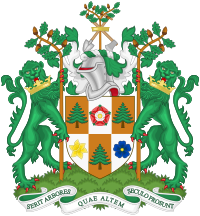 | |
| Abbreviation | RFS |
|---|---|
| Formation | 1882 |
| Founder | Henry Clark, John W Robson |
| Founded at | Northumberland |
| Type | Registered charity |
| Purpose | Woodland management |
| Headquarters | Banbury, Oxfordshire |
Region | England, Wales, Northern Ireland |
Main organ | The Quarterly Journal of Forestry (QJF) |
| Website |
www |
Formerly called | English Arboricultural Society |
The Royal Forestry Society (RFS) is an educational charity and one of the oldest membership organisations in England, Wales and Northern Ireland for those actively involved in woodland management.
The RFS has a broad membership which includes woodland owners, managers, countryside professionals (land agents, ecologists, conservationists), academics, students and others with a general interest in woodland management. Membership is open to all.
History
The Royal Forestry Society was established in 1882 in Northumberland, England. Originally known as the English Arboricultural Society, the organisation was founded by forester Henry Clark and nurseryman John W Robson, both from Hexham. The Society's first President was John Lambton, 1st Earl of Durham. In 1905 it was granted a Royal Charter by King Edward VII and was renamed the Royal English Arboricultural Society. It was renamed The Royal English Forestry Society in 1931, and in 1962 its title was changed to the Royal Forestry Society of England, Wales and Northern Ireland. [1]
A separate organisation operates in Scotland, the Royal Scottish Forestry Society, which was established in 1854. [2]
Woodlands

Although the Society is not a major woodland owner, it manages three working woodlands: [3]
- Hockeridge and Pancake Woods in the Chilterns, on the Hertfordshire/ Buckinghamshire border and close to Berkhamsted and Chesham, gifted to the RFS in 1986 by Mary Wellesley, great-great-granddaughter of the Duke of Wellington; [4]
- a 50-hectare (0.50 km2) woodland in the National Forest, close to Battram in Leicestershire;
- Charles Ackers Redwood Grove and Naylor Pinetum at Leighton Hall, Powys near Welshpool, Powys, the largest and oldest grove of coast redwoods in Europe.
These are managed as examples of good practice and lessons learned are shared with members.
Activities

The Society has 20 Divisions which between them organise up to 100 woodland field meetings a year on topics that span seed to sawmill. Annually: a top-level conference is held; there is a 4 or 5 day woodland study tour in England, Wales or Northern Ireland; Excellence in Forestry Awards take place, there is a travel bursary for forestry study abroad, and workshops, seminars and knowledge transfer events. Overseas study tours are held every other year.[ citation needed]
The RFS helps shape formal forestry qualifications and its own Certificate of Arboriculture is recognised across the sector; it encourages students with a range of awards, bursaries and internships; has launched a research programme with colleges and has partnered with a number of organisations to help share knowledge.[ citation needed] A professional qualification is offered by the RFS, the Professional Diploma of Arboriculture. [5] The RFS Teaching Trees project is expanding, introducing primary schools and their pupils to their local woodlands and their benefits to the economy, environment and society.[ citation needed]
The RFS maintains a library of forestry related books for members. [6]
The society is headquartered in the grounds of Upton House, Warwickshire, near Banbury. [7]
Journal
The primary publication of The Royal Forestry Society is the Quarterly Journal of Forestry [8] (since 1907). [9]
Arms

|
|
References
- ^ "History". www.rfs.org.uk. rfs. Retrieved 15 January 2020.
- ^ McDonald, Peter; Lassoie, J. P. (1996). The Literature of Forestry and Agroforestry. Cornell University Press. p. 97. ISBN 978-0-8014-3181-4.
- ^ "Our woods". www.rfs.org.uk. RFS. Retrieved 14 January 2020.
- ^ "Welcome to Hockeridge and Pancake Woods" (PDF). RFS. Archived from the original (PDF) on 14 January 2020. Retrieved 14 January 2020.
- ^ Konijnendijk, Cecil C.; Nilsson, Kjell; Randrup, Thomas B.; Schipperijn, Jasper (2005). Urban Forests and Trees: A Reference Book. Springer Science & Business Media. p. 471. ISBN 978-3-540-25126-2. Retrieved 15 January 2020.
- ^ "Notable Tree Collections in Powys". The Tree Register. Retrieved 2008-11-29.
- ^ "How To Find Us". www.rfs.org.uk. Retrieved 15 January 2020.
- ^ "publications". The Royal Forestry Society. Retrieved January 27, 2017.
- ^ "Quarterly Journal of Forestry". 1907. Retrieved January 27, 2017.
- ^ "Royal Forestry Society". Heraldry of the World. Retrieved 30 August 2022.
External links
- Forestry societies
- Organisations based in the United Kingdom with royal patronage
- 1882 establishments in England
- Nature conservation organisations based in the United Kingdom
- Environmental charities based in the United Kingdom
- Forests and woodlands of England
- Organisations based in Oxfordshire
- Environmental organizations established in 1882